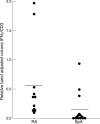Differential Th1/Th2 cytokine patterns in chronic arthritis: interferon gamma is highly expressed in synovium of rheumatoid arthritis compared with seronegative spondyloarthropathies
- PMID: 10733472
- PMCID: PMC1753106
- DOI: 10.1136/ard.59.4.263
Differential Th1/Th2 cytokine patterns in chronic arthritis: interferon gamma is highly expressed in synovium of rheumatoid arthritis compared with seronegative spondyloarthropathies
Abstract
Objective: To investigate possible differences in Th1 and Th2 cytokine mRNA expression in the synovial tissue (ST) of patients with rheumatoid arthritis (RA) and seronegative spondyloarthropathies (SpA) with diagnostic and/or pathogenic interest.
Methods: Eleven RA patients and 14 SpA patients (10 with undifferentiated spondyloarthropathy (USpA), two with ankylosing spondylitis (AS) and two with psoriatic arthritis (PsA)) were included. Th1 (interferon gamma, interleukin 2) and Th2 (interleukin 4, interleukin 5 and interleukin 10) cytokine mRNA levels from arthritic knee ST were quantified by using an optimised polymerase chain reaction method with a computerised analysis system. Protein levels of proinflammatory cytokines (interleukin 1, tumour necrosis factor alpha and interleukin 6) in synovial fluid were quantified with a specific ELISA test.
Results: Th1 cytokines were detected in all of RA ST samples in contrast with 58% (interferon gamma) and 71% (interleukin 2) of SpA samples. Th2 cytokines were expressed in 90% of RA ST samples, but the findings in SpA were interleukin 10 in 90%, interleukin 4 in 60% and interleukin 5 in 40% of ST samples. However, when the mRNA levels of each cytokine were quantified and corrected for T cell mRNA levels, only interferon gamma levels were significantly higher in RA than in SpA (p<0.003). Thus, the Th1/Th2 cytokine ratio in RA was fivefold that of SpA. Synovial fluid interleukin 1beta concentrations were higher in RA than in SpA (p<0. 05); there were also higher synovial fluid levels of tumour necrosis factor alpha in RA than in SpA, but without statistical significance.
Conclusion: This study has detected both Th1 and Th2 cytokine gene expression in ST from RA and SpA patients. Synovium interferon gamma mRNA levels and SF interleukin 1beta protein levels were significantly higher in RA than in SpA, so reflecting the known proinflammatory activity of interferon gamma through macrophage activation. Thus, the Th1 (interferon gamma)/Th2 (interleukin 4) ratio is significantly higher in RA than in SpA ST. These data confirm previous studies on ST Th1/Th2 balance in RA and extend previous work in comparing ST RA with subgroups of SpA distinct of ReA.
Figures



References
Publication types
MeSH terms
Substances
LinkOut - more resources
Full Text Sources
Other Literature Sources
Medical
Research Materials
Miscellaneous

